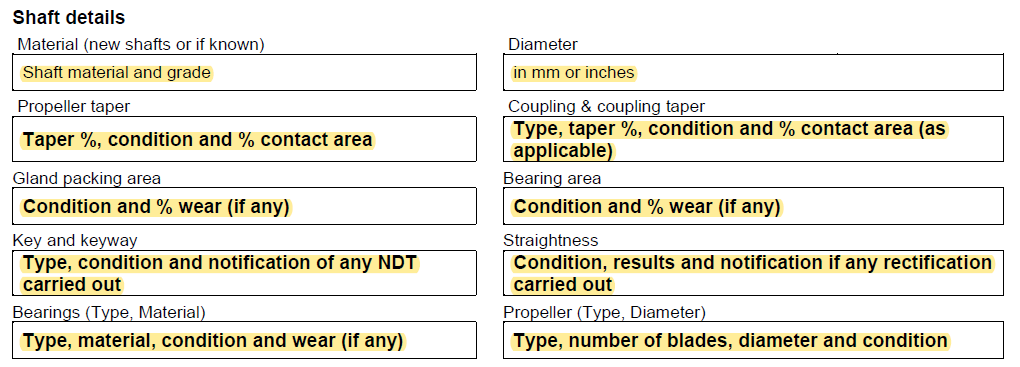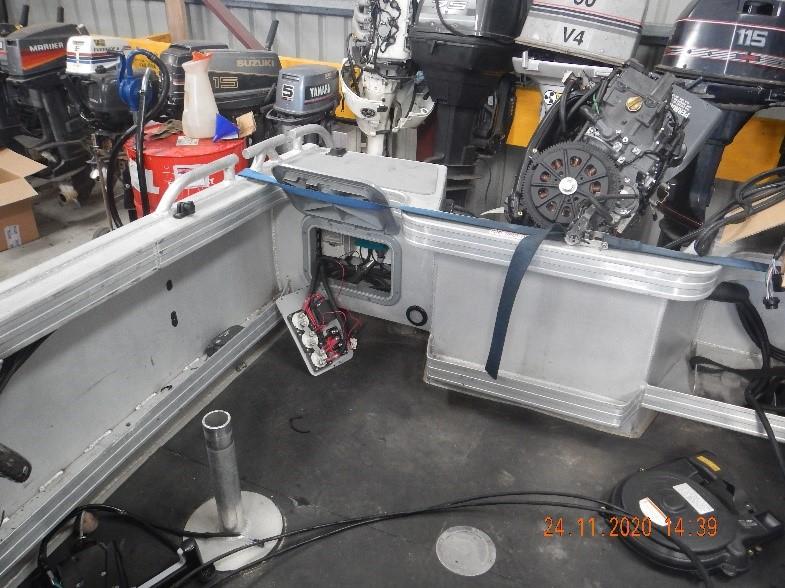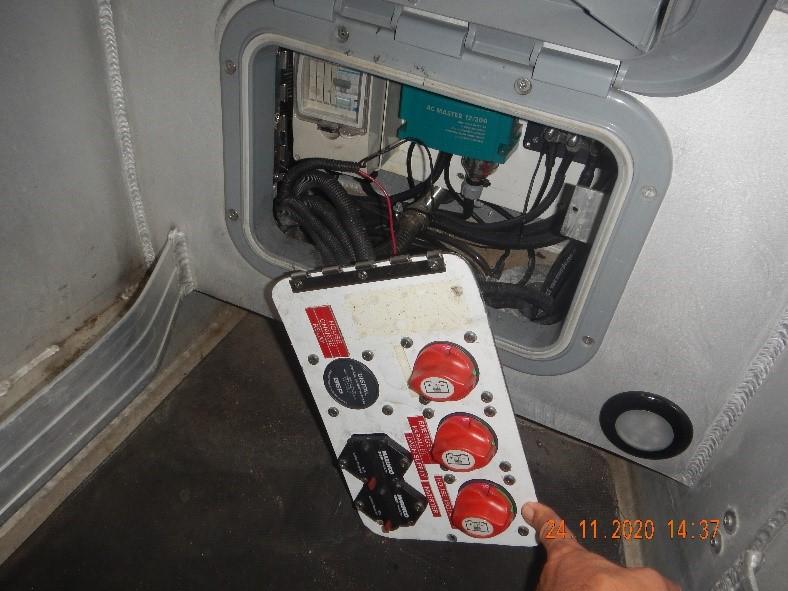- Renewing your accreditation
- Changes to identity cards
- Updates coming to MARS
- AMSA application review process
- Completing the AMSA 638 shaft survey report
- Load line survey frequency for vessels operating under Exemption 2 Division 5
- Working with the Fire Protection Industry Board to protect the environment, property and lives
- The importance of terminal covers
- Ultrasonic thickness measurements
- Upcoming certificate of survey renewals
- Simplified equipment lists for small fishing vessel operations
Renewing your accreditation
The Marine Safety (Domestic Commercial Vessel) National Law Regulation 2013 (the regulations) require an accredited marine surveyor to submit an application to renew accreditation on the AMSA 804 form, and pay the required fee, no less than three (3) months prior to the expiry of accreditation.
AMSA requires the full three months to process a renewal application and ensure:
- The surveyor has maintained their professional competence in the categories of surveying in which they are accredited.
- The surveyor’s work has been found, during any audits, to be satisfactory.
- Complete administrative and card processing work.
If there is an extraordinary reason as to why you were unable to submit your application three months prior to your accreditation expiring, AMSA may consider allowing a further period of time. Please be aware that requests to allow a further period must be in writing to AMSA from the accredited surveyor and may not be approved without extenuating reasons.
Since the start of 2021, AMSA has issued show cause notices to two accredited surveyors who failed to apply within the prescribed period. Subsequently Notices of Decision to refuse a further period of time were issued.
Are there consequences?
Yes. If your accreditation expires, a new application for accreditation, including payment of the initial fees and interview for the categories of accreditation is required.
Changes to identity cards
Accredited marine surveyor identity cards underwent a change in December 2020. Cards no longer list a surveyor identification number; instead, they list your unique AMSA ID number which will never change. This change effects all cards issued after December 2020.
Using existing surveyor ID
You can use your existing surveyor ID number, however we recommend that you transition to the AMSA ID.
Using existing surveyor ID card that does not have an AMSA ID
Your card is valid until you submit a new or renewal application and receive an updated card.
Surveyor ID on the AMSA form
Existing AMSA forms require you to fill in the ‘Surveyor ID’ field. You can populate either your Surveyor ID or AMSA ID in this field.
Updates coming to MARS
MARS updates, focused on increasing the efficiency of certification, are in the pipeline.
The updates include changes to the management of supporting documents in MARS, and updates to the way ‘surveys required’ letters are generated.
Changes to the supporting document
MARS activities currently have a general file upload button.
After the update, each survey activity will have its own specific survey documentation upload buttons. For example, the hull survey activity will have a specific place to upload the expected hull survey report.
If a user chooses not to upload an expected document, a warning message will appear when the recommendation is made in MARS.
A user may still proceed without uploading the document, however this will cause delay or may ultimately result in a refusal of the application.
Reason for the changes
The most common reason applications are delayed or refused is because they are incomplete.
These changes aim to improve submission quality, allowing AMSA to complete applications with less manual checks, and provide faster outcomes for you and your clients.
The ‘surveys required’ letter changes
Currently ‘surveys required’ letters are automatically generated by the MARS system, containing a comprehensive list of survey codes.
This update will allow AMSA to check and customise survey codes on these letters before they are sent to the applicant.
Reason for the changes
These changes allow AMSA to communicate survey requirements more clearly to applicants and reduce the administrative burden for survey.
Expected date of updates
These system updates are currently undergoing initial testing by the system developer.
We will let you know when the changes take effect.
AMSA application review process
To ensure AMSA is providing a high level of service and meeting stakeholder expectations, AMSA has internal service guidelines.
In most cases, AMSA will consider an application within 10 business days of completion.
The maximum period allowed for AMSA to consider and decide most applications is 90 days. This maximum time frame is provided to ensure AMSA considers and decides applications within a reasonable period. That is, AMSA must decide to approve or refuse the application within the time frames prescribed in Marine Order 501.
In cases where there is insufficient information to approve an application, AMSA delegates will request additional information from the applicant.
About the process
AMSA will review the application and if necessary information is available, make a decision on the application.
However, if additional information is required, AMSA will send the applicant a request for further information, usually by email.
AMSA will allow a reasonable period for the applicant to obtain and supply the requested information.
After the request period has passed, AMSA will consider and decide the application based on the information available to us.
Questions and answers
What if I don’t think the information AMSA requested is necessary or reasonable?
Answer: You should review the applicable Marine Orders and the Surveyor Manual. An applicant can choose to omit the information, AMSA has requested. At the end of the request period AMSA will consider the application based on the available information. If the requested information has not been provided, it is possible AMSA may refuse the application.
What if I don’t believe the period for the request is reasonable?
Answer: Just ask to extend the time period and AMSA may extend if there is sufficient reason. Please note a reasonable period will be set for the requested information as required by Marine Order 501, after which a decision will be made.
What can I do if the application is refused?
Answer: If an application is refused on the basis of insufficient information, just apply again when the information is available.
Alternatively, a refusal decision made by AMSA may be reviewable. This means certain rights of review may arise for the applicant. Further information regarding these rights will be provided at the same time the applicant is given a written notice of the decision.
Completing the AMSA 638 shaft survey report
We have found significant variation in the quantity and quality of information provided on the AMSA 638 form in the Shaft details section.
The information AMSA expects to see in the Shaft Details section of the AMSA 638 form is detailed in the image below. We understand there are times when some of this information isn’t available to the surveyor, nonetheless the provision of this information is considered appropriate and should be sourced wherever possible.
 Load line survey frequency for vessels operating under Exemption 2 Division 5
Load line survey frequency for vessels operating under Exemption 2 Division 5
Vessels operating under Exemption 2 Division 5 which are required to hold a load line certificate must undergo load line surveys in accordance with the Marine Surveyors Accreditation Guidance Manual (SAGM).
Chapter 6.3.2 (1) of SAGM refers to Marine Order 507 for periodic survey frequency requirements.
Division 2(7)(f) of MO507 states:
“if a vessel does not have a certificate of survey, the periodic survey mentioned in paragraph (d) must occur according to the frequency that a periodic survey would be required for a certificate of survey under Marine Order 503 if the vessel was required to have a certificate of survey;”
Periodic load line surveys must be completed within the 3 months before, or 3 months after the due date listed in the survey schedule on page 2 of the load line certificate.
Working with the Fire Protection Industry Board to protect the environment, property and lives
Written by the Fire Protection Industry (ODS & SGG) Board.
By working with the Fire Protection Industry (ODS & SGG) Board (FPIB), accredited marine surveyors can help protect the environment, the safety of vessels, and the lives of those onboard.
The FPIB administers the fire protection industry permit scheme on behalf of the Australian Government. The permit scheme aims to reduce unnecessary emissions of extinguishing agents that are ozone depleting substances (ODS) and synthetic greenhouse gases (SGG), known as scheduled extinguishing agents.
Surveyors can minimise the risk of accidental discharges of scheduled extinguishing agents by ensuring that fire suppression systems and portable fire extinguishers on domestic commercial vessels are installed, maintained, tested and decommissioned in line with the permit scheme.
Scheduled extinguishing agents are harmful if discharged into the atmosphere. Depending on the type, these substances can either damage the earth’s ozone layer and/or contribute to global warming. The most common scheduled extinguishing agents found in vessels are FM-200, NAF-SIII and FE-227.
Vessel owners or operators should only use licenced technicians as they are suitably qualified and skilled. Using unlicensed technicians is potentially damaging for the environment. It also puts at risk the safety of vessels and the lives of those onboard.
It is an offence under the Ozone Protection and Synthetic Greenhouse Gas Management Regulations 1995 to handle scheduled extinguishing agents without an appropriate fire protection industry permit. It is also an offence to breach any conditions of that permit.
Surveyors can assist the FPIB with a few simple measures:
- When work on a fire suppression system or a portable fire extinguisher is needed, encourage the vessel’s owner to confirm that the technician holds a valid fire protection industry permit by contacting the FPIB on 1300 731 922 or by email.
- If a technician has already been engaged and has performed the work, check the maintenance logbooks. You may contact the FPIB to confirm they hold a valid fire protection industry permit.
- If a scheduled extinguishing agent has been discharged from a fixed fire suppression system or portable extinguisher, please report this to the FPIB via their short online discharge notification form. Note, it is an offence under the Ozone Protection and Synthetic Greenhouse Gas Management Act 1989 to discharge a scheduled extinguishing agent outside of the Regulations.
For further information on scheduled extinguishing agents in the marine industry, see the FPIB’s factsheet.
The importance of terminal covers
The incident below occurred in 2020 and highlights the importance of insulating bare conductors and terminals.
The incident demonstrates the benefits of conducting regular maintenance on electrical systems, particularly ensuring all components are secured.
This 4.35m vessel suffered a short circuit, as a result of a hinge pin working loose, causing the battery switch panel to drop onto the aluminium hull (see pictures below).
The high current flow through a short circuit generates heat that can cause a fire. Isolating the battery is the only way to stop the high current flow in the engine start circuit. In this instance the throttle cables, ignition system and outboard components melted and generated smoke.
Fortunately, the operator wasn’t far from the boat ramp and was able to make shore. The consequences could have been worse if they were operating further seaward and unable to identify the cause.


Ultrasonic thickness measurements
The Marine Surveyor Accreditation Guidance Manual (SAGM) provides limited guidance on Ultrasonic Thickness Measurements (UTM) required as part of 10-yearly renewal survey.
SAGM 2.7(2)(d) and Example 2 contain reference to UTM but do not provide details about the requirements and conduct of the UTM itself. Neither the NSCV nor the USL Code provide information nor was there a uniform approach adopted by the state authorities.
AMSA plans to address this gap and is currently developing guidance material in the form of an Instruction to Surveyors. The instruction will be based around the existing IACS recommendations (Z7 and Z7.1) adapted for domestic vessels less than 35m. Note: Vessels maintained in class must continue to follow the requirements of their recognised organisation for renewal surveys.
The intention of the instruction is to provide guidance to accredited marine surveyors in the following areas:
- General Requirements – such as access arrangements and cleaning requirements.
- Conduct of the Survey – requirements of the surveyor and the UTM company and the execution of the survey onboard the vessel.
- Extent of Survey - what is required at each 10, 20 and 30+ year renewal surveys.
- Reporting - the what and the how of reporting.
- Acceptance criteria – for the different type and measured length of vessel and for different material types.
The purpose of the UTM is to ensure that wastage affecting the vessel’s structural, or weathertight/watertight integrity is identified and repaired to the surveyor’s satisfaction.
We will contact accredited marine surveyors for feedback when the draft instruction is available.
Upcoming certificate of survey renewals
In NSW, a large number of certificates of survey will be due for renewal in the next 6 months, you can expect an increase in renewal survey requests.
A number of vessels in NSW that have certificates of survey were not previously subject to ongoing periodic (or renewal) surveys. Due to changes to the law in 2018, those vessels are now required to undergo survey in order to renew their certificates of survey.
Renewal surveys can be conducted anytime in the six months prior to the expiry date of the current certificate. We encourage you to upload the surveyor reports directly to AMSA systems—to reduce processing times.
Simplified equipment lists for small fishing vessel operations
Two simplified equipment lists are now available for certain non-survey vessels less than 12 metres long, working close to land.
The equipment requirements depend on where and how far from land a vessel operates.
- Fishing vessels working in warm waters and operating within 2 nautical miles of land
- Beach fishery vessels operating within 200 metres of land, anywhere in Australia.
Eligible vessels must be operating under Exemption 2 (certificates of survey) or Exemption 40 (class C restricted operations).
No application is required to use the equipment lists for vessels operating under these conditions. Operators must simply ensure they carry all the required safety equipment.
These changes to safety equipment requirements have taken shape through collaboration and consultation with industry. You can read more about the equipment lists on the AMSA website. The consultation feedback report is also available.